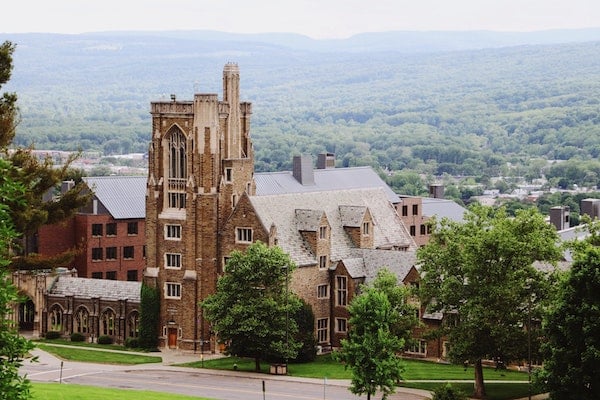Published on
It Takes a Village to Enroll a Class

With uncertainty clouding the upcoming fall semester, students are hesitant to enroll in school at the moment. Many are beginning to look at taking a gap year, which will highly affect colleges and universities in both enrollment rates and student retention. In this interview, Angel Perez discusses how institutions can address the summer melt issues, maintain relationships with deferred students and have a strong digital presence, especially in this time.
The EvoLLLution (Evo): Why are we likely to see an increase in gap years for students in the foreseeable future?
Angel Perez (AP): There are a variety of different reasons. We’re in the midst of a global pandemic, and there are a lot of uncertainties. Several themes have emerged from conversations I’ve had with students. The first is that of anxiety, particularly from parents about their children going back to the highly residential postsecondary environments. Everything we do is about being in proximity. So, there’s a lot of anxiety about whether or not colleges and universities will be able to follow government guidelines for social distancing.
The second theme is practicality. Many international students may not be able to come back to school this year. The borders are closed, and the United States have immigration policies that are not in our favour. As a result, these students feel tremendous anxiety about getting visas or worry whether the embassies will reopen. It’s a huge logistics challenge. For many schools, international students make up a significant part of the population. A lot of those students may decide to take a gap semester or year.
The last theme would be the willingness to start a semester online. There is the possibility that if we have another outbreak, even colleges and universities that have every intention of reopening may not be able to do so, and students are worried. They have a romantic notion of what it’s like to start college—we all do–and for traditional students, going online is not something that they imagined. So, students are waiting to see what institutions will do and will respond accordingly.
Evo: In thinking about the differentiated impact on postsecondary institutions, do you see these issues as being more relevant to the smaller, private liberal arts colleges than they are to say community colleges or universities–or are these going to be distributed impacts across the board?
AP: Community colleges may not face as much on the international front because most community colleges’ students are physically in the United States. But that anxiety about safety is felt across the board. Where it may be different is in the returning adult population. That population is a huge growing portion of American higher education, so we definitely need to be on the pulse of their needs and concerns.
Some of those populations are a little bit more accustomed to taking courses online. But for traditional students, the American college dream is fading. It will likely be impossible to deliver traditional orientation and welcome students into the dorms. That’s an issue that many colleges will have to face.
Evo: What can colleges and university leaders do to try to prevent, or at least minimize some of these summer-melt possibilities?
AP: As colleges and universities, this is the year to say to families, “We are going to be flexible, and we are going to be nimble, and we are going to remove any barriers in order for you to be able to enroll whenever it is that you feel comfortable.”
Colleges and universities don’t tend to be flexible when it comes to policies. For example, they could be a little bit more flexible with enrollment deadlines. We moved our enrollment deadline up this year to give families a little bit more time–being more flexible with granting gap semesters or gap years. The other thing that colleges can do is have contingency plans. At Trinity, we are planning to be online, but we also looking what a safe on-campus experience would look like? Part of the issue is that colleges and universities need to be working at the speed of light to create a variety of different options. They need to understand that one size does not fit all in this case.
This is the summer to over communicate with your students and their families. Tell them the decisions that you are making, send frequent communications, check in on them, and survey your population. Last week, we at Trinity surveyed returning students. We wanted to know where they are and how they’re feeling about coming back. Then we took those responses and turned them into actions. In the end, the students and families are the consumers.
Evo: How do you maintain a relationship with incoming students who decided to defer, to ensure that they will come back and enroll?
AP: One of my favorite quotes is from Maya Angelou, and that is, “People forget what you said, people forget what you did, but they will always remember how you make them feel.” Students and families in this situation are going to remember which colleges make them feel the best. And I don’t mean warm and fuzzy feelings. What I mean by that is which institution cared, listened, stayed in touch with me… And which institution really is trying to be flexible and nimble to my needs and cares about me as a student?
It sounds simple, but we tend to be really robotic in higher education. This is the time to have faculty members and current students reach out to new students, especially those taking gaps years, to make sure communication is still in place. Interactions need to be deeply personalized for all of those students, so that they stay engaged and identity themselves with the institution. If an institution doesn’t stay in touch with a student or help them feel like they’re part of the family–even if they’re not already there—they risk losing that student to another institution.
Evo: Looking at the long-term, what will be the lasting impact of this experience on the way that we do the business of higher education?
AP: I wish I had a crystal ball for that. We’re at this really interesting crossroads, making this is a pivotal moment for higher education. Higher education will always exist, but it may look different after the pandemic. In some ways, that could be really good. This pandemic is forcing us to question everything that we do. It also forces us to ask ourselves, “Are some of our policies still relevant? Are some of the ways that we function still relevant, or are there better, more student-centric ways to do this?” I have hope that the university is going to be a different university on the other side—one that is much more student-centered, flexible and nimble, even possibly funded a little bit differently.
Something that has really opened legislators’ eyes in this crisis is that there are many schools in this country that were three months away from bankruptcy if they didn’t collect tuition. That is not the kind of nation we want to be. But to a certain extent, it’s the kind of nation we have to be because higher education is not a priority in public funding. We essentially put out the message that higher ed is not a public good when we all know it should be considered as one. I do hope that we don’t let a good crisis go to waste. This is a massive one that we could really use as an opportunity to reshape everything we do.
Evo: How important is an institution’s digital presence to keeping new students and applicants engaged and informed as we go through this very muddy next few months to next year?
AP: Digital presence is extremely important, and it’s true that one size will not fit all. You can’t just post on Facebook and Instagram and send out a mass email. Many students don’t even check email. Part of it is constantly reinventing and keeping up with the trends but also asking our students how they prefer to communicate.
It’s been very interesting to see that in the midst of this crisis, students, particularly young students now, don’t pick up the phone. We did a phone campaign to check in on our students, and so many of them not only picked up the phone but were deeply grateful for the personal connection. That’s one of the reasons behind “one size doesn’t fit all” education.
We have to continue ramping up our digital presence, getting better at it to try to individualize the student experience. At the same time, there’s something missing in this crisis: the personal touch. Institutions with faculty, staff, alumni and parents calling students or saying, “Hey, can I FaceTime with you?” All of the calls that I made to students that I mentor at Trinity all ended with, “Thank you so much for doing this. This made my day–the fact that you care.” And right now, students just want to know that you care.
Evo: Is there anything you’d like to add about what it’s going to take to create these lasting and enriching relationships with prospects and with incoming learners, that will help them persist through an extremely challenging period?
AP: It takes a village to enroll a class. This is not just the admissions office’s responsibility. We made the class and filled it with students. However, it is now the faculty’s responsibility to help us keep them. An entire community must come together.
What I worry about is that there are still a lot of schools that feel that in this environment, it’s the sole responsibility of admissions officers to enroll a class. That is not the case. Students want to hear from community members and current students. The more that colleges and universities can mobilize their entire community around making sure that they get students excited about enrolling, the more successful they will be.
Evo: We’re so passionate about making sure that we reinvent the wheel per faculty from soup to nuts–what do we do to fix that?
AP: Part of it has to become structural. As vice president for enrollment and student success, I oversee a division that looks at the life cycle of the student from enrollment all the way through graduation. One of the offices I oversee is career development. And when you construct it that way, it shifts the mindset of the entire institution that the admissions office is not just responsible for admitting students, but they’re responsible for cultivating and retaining them. I also oversee retention and the truth is, it’s a lot of pressure because I’m responsible for many of the highly visible outcomes data at the institution. But the reality of the matter is it has shifted the culture of the organization.
The other piece that’s really critical is that you need to have a champion at the top. We need to create ecosystems of enrollment, ecosystems of retention, ecosystems of student satisfaction. My job is to go to all the different groups and politic every single group and remind them that it takes a village to do all of this work. All of us have to work together towards the same goals. If students don’t show up, your job description doesn’t matter. You have to create structural systems at the top, but you also need people in critical roles who are seen as unifiers on the campus. That’s the future direction of higher education.
This interview was edited for length and clarity.
Editor’s note: This interview was recorded on June 3, 2020.
Disclaimer: Embedded links in articles don’t represent author endorsement, but aim to provide readers with additional context and service.
Author Perspective: Association



